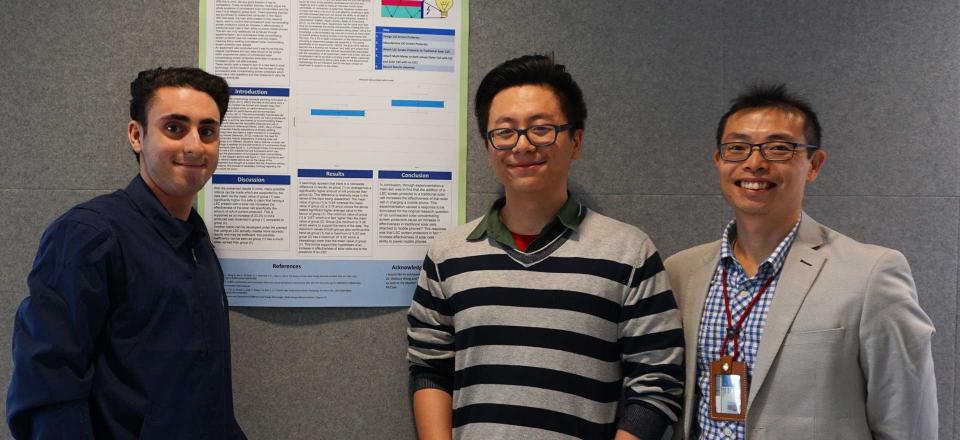Bright ideas at the EBSS Research Poster Symposium

5 October 2016
Could the screen protector on your mobile phone, harness sunlight to power or recharge your phone?
Christian Scaramozzino thinks so and has used his year 11 project of the Extended Investigations VCE subject at the Elizabeth Blackburn School of Sciences to try to prove it.
He is standing in front of his scientific poster at the Elizabeth Blackburn Science School Extended Investigation Poster Symposium, 5 October 2016 that showcases his year’s work designing and conducting experiments with the guidance of his mentor Quentin Hong, PhD student at the Bio21 Institute.
“I’ve invented an adaptation for a traditional solar cell, which causes an increase in effectiveness in their ability to power mobile phones,” he explains.
“Basically you create a so-called ‘luminescent solar concentrating screen protector’ that concentrates light to the edges of a transparent surface, such as a clear piece of tinted glass, or plastic screen-protector,” he explains.
“Because light is concentrated to the edges, they glow. When this concentrated light is then focussed on to a solar cell, the light energy can be converted to electricity that recharges or powers your phone.”
Chris McCaw, one of the EBSS teachers of the Extended Investigations subject, identified Bio21’s Quentin Hong as a mentor for Christian.
“The students drive their own project,” he explains. “They picked their own question and see it through to experimental design and execution,” he says. "The very challenging, but rewarding Extended Investigations subject has been taught in its third year at the school and the poster session has been included by the school, as a celebration of their work and to practice their defence.”
“Students learn research and critical thinking skills that are extremely valuable both in the short and long term,” explains Chris McCaw.
In the course of his project, Christian met his mentor, Quentin on a weekly basis. ‘We even met in the school holidays” explains Christian.
“Because there was very little scientific literature on the subject as it is a relatively new field, Quentin encouraged me to demonstrate my concept experimentally."
So, Christian purchased a special fluorescent Perspex, as well as creating a unique flourescent dye to act as a luminescent solar concentrating screen protector and strapped a solar cell to its edges. Using a multimeter attached to his invention, he recorded the amount of current in milliamps (mA) produced by the solar cell using a set-up with the luminescent solar conentrating screen protector and without it. He took measurements of the sunlight captured on three different days, with different light conditions. The presence of the luminescent solar concentrating screen protector increased the efficiency of the solar cell by over 20 percent. The results were encouraging and although the overall amount of energy produced was not sufficient to be a viable source of power, Christian is keen to pursue this line of research to increase the efficiency.
“Quentin gives you a bit, then let’s you go off and do your own research; he taught me experimental design,” explains Christian. Dr Wallace Wong also gave Christian a tour of their laboratory, where they are creating printable plastic solar cells and are developing various dyes to be used in luminescent solar concentrators. “He inspired me to pursue my interest,” explains Christian.
Christian, who relished the problem-solving aspect of the work, also admits to having a bit of an entrepreneurial knack. He has applied to pitch his idea to ‘Shark Tank’ to eventually develop the concept further as a product for the market.
By Florienne Loder

